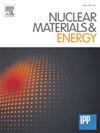Study on the corrosion behavior of static liquid Pb-16.7Li on the structural material CLF-1 steel
IF 2.7
2区 物理与天体物理
Q1 NUCLEAR SCIENCE & TECHNOLOGY
引用次数: 0
Abstract
In liquid Pb-Li tritium breeding blanket, the compatibility between liquid Pb-Li and Reduced-activation-ferritic-martensitic (RAFM) steel structure material is crucial for the successful application of the RAFM steel. Corrosion experiments on CLF-1 steel in static Pb-Li at 550 ℃ were conducted for up to 1200 h to figure out the corrosion behavior and mechanism. After exposure, a subset of specimens was cleaned by mixed acid dissolution, while the remaining samples were cold-mounted in resin for cross-sectional observation. X-ray Diffraction (XRD), Scanning Electron Microscopy (SEM), Energy Dispersive Spectroscopy (EDS), Time-of-Flight Secondary Ion Mass Spectrometry (ToF-SIMS) and Electron Backscatter Diffraction (EBSD) measurements were employed to characterize the corrosion behavior and reveal the corrosion mechanism. With increasing exposure time, corrosion initiates at grain boundaries and spreads laterally, producing boundary ditches, hollows, protrusions, and ultimately pebble‑like grains. It is proposed that corrosion occurs through the dissolution of Fe and Cr, facilitated by the diffusion of Li into the grain boundaries and grains, as well as the penetration and adsorption of Pb.
静态液体Pb-16.7Li对结构材料CLF-1钢的腐蚀行为研究
在液态Pb-Li氚孕育毯中,液态Pb-Li与还原活化铁素体-马氏体(RAFM)钢结构材料的相容性是RAFM钢能否成功应用的关键。对CLF-1钢在550℃的静态铅酸锂中进行了长达1200 h的腐蚀实验,研究了其腐蚀行为和机理。暴露后,将一部分样品用混合酸溶解清洗,其余样品用树脂冷装进行截面观察。采用x射线衍射(XRD)、扫描电子显微镜(SEM)、能量色散光谱(EDS)、飞行时间二次离子质谱(ToF-SIMS)和电子背散射衍射(EBSD)等测量方法对腐蚀行为进行了表征,揭示了腐蚀机理。随着暴露时间的增加,腐蚀从晶界开始并向横向扩散,形成晶界沟槽、空洞、突起,最终形成卵石状晶粒。提出腐蚀发生在Fe和Cr的溶解,Li扩散到晶界和晶粒中,以及Pb的渗透和吸附。
本文章由计算机程序翻译,如有差异,请以英文原文为准。
求助全文
约1分钟内获得全文
求助全文
来源期刊

Nuclear Materials and Energy
Materials Science-Materials Science (miscellaneous)
CiteScore
3.70
自引率
15.40%
发文量
175
审稿时长
20 weeks
期刊介绍:
The open-access journal Nuclear Materials and Energy is devoted to the growing field of research for material application in the production of nuclear energy. Nuclear Materials and Energy publishes original research articles of up to 6 pages in length.
 求助内容:
求助内容: 应助结果提醒方式:
应助结果提醒方式:


